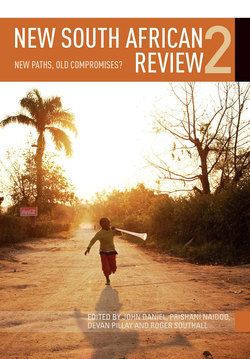Читать книгу New South African Review 2 - Paul Hoffman - Страница 9
На сайте Литреса книга снята с продажи.
A ‘GREEN ECONOMY’?
ОглавлениеOne of the focus areas envisaged as a key site of job creation by the NGP is ‘the green economy’: those industries and services related to the realisation of profits through the provision of environmentally friendly approaches to different aspects of the functioning of society. In its own words:
The New Growth Path targets 300 000 additional direct jobs by 2020 to green the economy, with 80 000 in manufacturing and the rest in construction, operations and maintenance of new environmentally friendly infrastructure. The potential for job creation rises to well over 400 000 by 2030. Additional jobs will be created by expanding the existing public employment schemes to protect the environment, as well as in production of biofuels. The IRP2 targets for renewable energy open up major new opportunities for investment and employment in manufacturing new energy technologies as well as in construction. (NGP Framework, 2010: 13).
While such pronouncements are welcome signs of growing commitments to legitimate concerns about the effects of capitalist production on the environment, the chapter by Khadija Sharife and Patrick Bond in this volume shows that there are other policy choices that the post-apartheid state has made that suggest that such commitments to addressing environmental concerns might be driven by the needs of the market rather than by any ethical stand. For example, state support for Eskom’s massive expansion of coal- and nuclear-generated electricity projects suggests a greater prioritisation of the interests of profit generation than of the environmental well-being of the country and the health of its people. In the case of South Africa, it is probably a combination of market forces and the interventions of environmental NGOs and activists that determines the final policy choices made by government.
This is quite evident in William Attwell’s chapter, which presents a discussion of the different interests at stake in a particular concern related to ‘the green economy’: that of bio-fuels. Surveying state, business and civil society approaches to the bio-fuels debate in South Africa, Attwell relates how well-intentioned attempts at addressing environmental concerns such as climate change, energy security, and rural development through increasing the production and use of bio-fuels, increasingly came under criticism globally as bio-fuels were said to be diverting land and resources away from essential food production, contributing to food price increases across the world: the ‘food versus fuel’ debate.
Through a close analysis of the South African policy process related to bio-fuels, Attwell shows how strong lobbying from civil society groups helped to shape the final policy, ensuring that maize, one of South Africa’s main crops, was excluded from the list of food stocks available for bio-fuel production. However, he also shows more recent shifts in state policy towards bringing together commitments to food security and energy production. Of particular importance is Attwell’s demonstration of a renewed commitment on the part of the state, in particular regarding agriculture, to creating jobs and economic growth through increasing its production of bio-fuels, as the market in bio-fuels has shown greater promise of returns.
But while the NGP’s (and the broader state’s) commitment to ‘greening the economy’ focuses on the potential for environmental concerns to meet the needs of the market (through job creation and/or more efficient production processes), the existing deleterious effects of capitalist development on the environment continue largely unaddressed. In this volume the chapters by David Fig and by Khadija Sharife and Patrick Bond describe how Johannesburg might literally find its insides outside not too far into the future as polluted water from old mines flows into the surface watercourses and underground aquifers in the surrounding areas of these closed mines, in what has come to be known as acid-mine drainage. This is the term applied to water that becomes contaminated when it comes into contact with sulphide-bearing rocks in the presence of oxygen, and it happens in old mine-shafts when rain water mixes with underground iron pyrite (‘fool’s gold’) and other minerals that break down. Fig points out that the practice of pumping this contaminated water out of the mines stopped with their closure, meaning that the level of acid mine drainage is constantly rising underground at different rates in different parts of the Witwatersrand.
While Fig celebrates the work of civil society activists and NGOs in putting the issue of acid mine drainage on the agenda of the state and big business, he argues that much more must be done in the way of revising policy in an integrated manner that will recognise the urgency of addressing the acid mine drainage, establishing proper legislation and regulatory frameworks, and looking for solutions that protect public health, the natural environment, the built environment, and protected sites such as the Cradle of Humankind. As the NGP searches for opportunities in environmental concerns for job creation, it is equally important that the existing damages inflicted on the natural and built environments by processes of production under capitalism, are also addressed.
